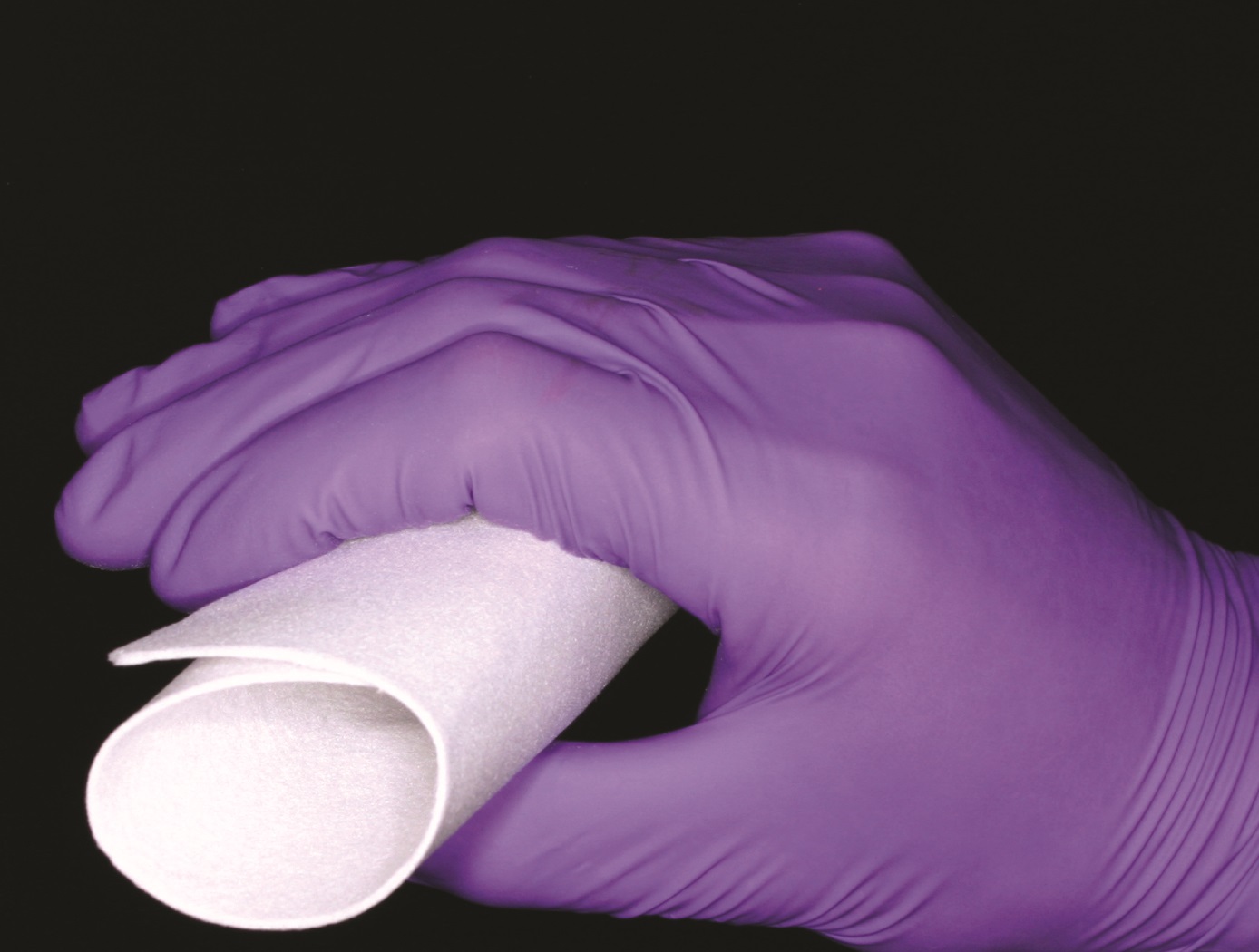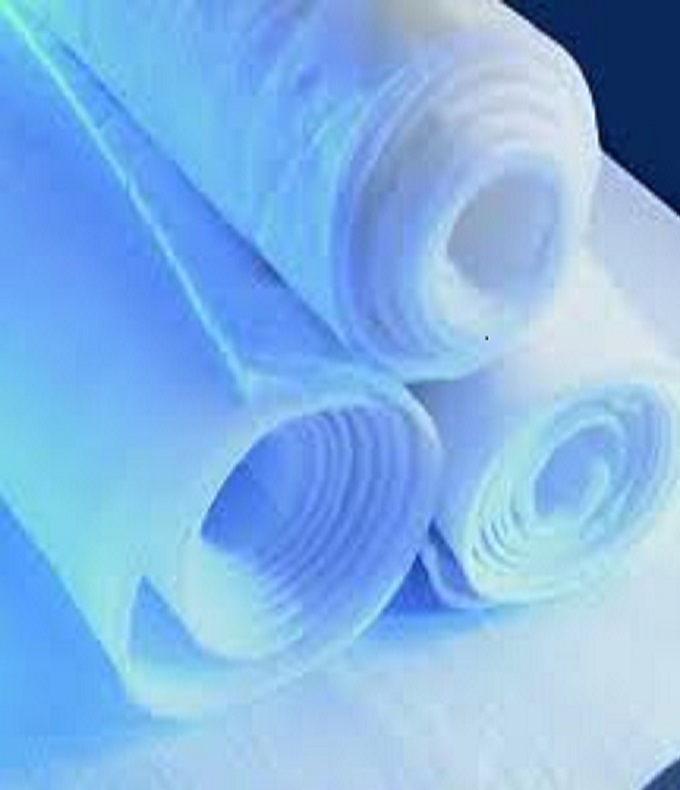Aerogel Reinforced Composites
materials and coatings
Aerogel Reinforced Composites (LEW-TOPS-141)
Improving the state of the art with insulation materials for environments of up to 1200°C
Overview
NASA's Glenn Research Center (GRC) has developed a method for fabricating low-density, flexible aerogel composites for use as thermal insulation for myriad applications. It is ideal for a variety of environments that require insulation materials that can withstand temperatures of up to 1200°C. This innovation significantly advances the state of the art for composite insulation systems, reducing adherence problems and thermal conductivity limitations of conventional aerogel insulations while improving performance with lower weight and lower density, and higher efficiency, all factors contributing to greater applicability of aerogel insulation.
The Technology
GRC's aluminosilicate aerogel composites are fabricated using a sol-gel technique. A sol is formed by hydrolyzing an alumina dispersion in acid solution; the alumina may be combined with a silicon precursor to create a sol.
Fabrics, papers, and felts are used as reinforcing fibers to form an aerogel composite. The aerogel adheres to the reinforcement without use of sizing or organic binders. (In the case of sized fabrics, the sizing is first removed by heat cleaning.) Composites can be fabricated in a batch process, impregnating individual layers of paper, felt or fabric with the precursor sol, or in a roll-to-roll process. The sol is allowed to gel, and then aged for several days prior to supercritical drying using liquid CO2. Heat treatment of the super critically dried composites can be used to tailor the alumina or Aluminosilicate crystal structure and pore size.
In contrast to commercially available insulations, GRC's innovation provides extremely low thermal conductivity (60 mW/m-K at 900°C in argon) at high temperatures, thus enabling use at higher temperatures and improving applicability. In addition, GRC's unique process provides very good adhesion of the aerogel to its reinforcing fibers in alumina papers and zirconia felts, eliminating the spalling seen in other aerogel composites. Finally, GRC's innovation demonstrates low density and extreme resilience to high temperatures and harsh conditions. Seven layers of composite material of 1.25 mm/layer produced a temperature drop of 700°C when tested in the 8-foot high-temperature wind tunnel (8 HTT) at NASA's Langley Research Center. The technology also has withstood heat tests of up to 1200°C. In combination with other insulators, it has withstood fluxes of up to 65 W/cm2, producing a temperature drop of 625°C across 8 mm.


Benefits
- Robust - strong adhesion to reinforcing fibers greatly reduces flaking and loss of aerogel particles compared with other aerogel insulations
- High thermal range - very low thermal conductivity provides better insulating capability at higher temperatures
- Low density - its very low density is one-third that of the state-of-the-art insulation materials
- Resilient - testing of the aerogels showed they can successfully withstand temperatures of at least 1100°C without collapse of the pore structure
- Flexible - the strength and handling capabilities have not previously been seen with existing seals and aerogels
Applications
- Insulation (up to 1100°C)
- Thermal protection systems (fire blankets, tents, heat shields)
- Inflatable decelerators
- Aerospace
- Automotive
- Marine
- Military
- Unmanned vehicles
- System protection
- Commercial space
- First responders
Technology Details
materials and coatings
LEW-TOPS-141
LEW-19098-1
LEW-19098-2
LEW-19098-3
Similar Results

Polymer Cross-Linked Aerogels (X-Aerogels)
Researchers at NASA's Glenn Research Center have developed an approach to significantly improve the mechanical properties and durability of aerogels without adversely affecting their desirable properties. This approach involves coating conformally and cross-linking the individual skeletal aerogel nanoparticles with engineering polymers such as isocyanates, epoxies, polyimides, and polystyrene. The mechanism of cross-linking has been carefully investigated and is made possible by two reactions: a reaction between the cross-linker and the surface of the aerogel framework and a reaction propagated by the cross-linker with itself. By tailoring the aerogel surface chemistry, Glenn's approach accommodates a variety of different polymer cross-linkers, including isocyanates, acrylates, epoxies, polyimides, and polystyreneenabling customization for specific mission requirements. For example, polystyrene cross-linked aerogels are extremely hydrophobic, while polyimide versions can be used at higher temperatures. Recent work has led to the development of strong aerogels with better elastic properties, maintaining their shape even after repeated compression cycling. By tailoring the internal structure of the silica gels in combination with a polymer conformal coating, the aerogels may be dried at the ambient condition without supercritical fluid extraction.

Layered Composite Insulation for Extreme Conditions (LCX)
The approach in developing the LCX system was to provide a combination of advantages in thermal performance, structural capability, and operations. The system is particularly suited for the complex piping, tanks, and apparatus subjected to the ambient environment common in the aerospace industry. The low-cost approach also lends the same technology to industrial applications such as building construction and chilled-water piping. The system can increase reliability and reduce life cycle costs by mitigating moisture intrusion and preventing the resulting corrosion that plagues subambient-temperature insulation systems operating in the ambient (humidity and rain) environment. Accumulated internal water is allowed to drain and release naturally over the systems normal thermal cycles. The thermal insulation system has a long life expectancy because all layer materials are hydrophobic or otherwise waterproof. LCX systems do not need to be perfectly sealed to handle rain, moisture accumulation, or condensation.
Mechanically, the LCX system not only withstands impact, vibration, and the stresses of thermal expansion and contraction, but can help support pipes and other structures, all while maintaining its thermal insulation effectiveness. Conventional insulation systems are notoriously difficult to manage around pipe supports because of the cracking and damage that can occur. Used alone or inside another structure or panel, the LCX layering approach can be tailored to provide additional acoustic or vibration damping as a dual function with the thermal insulating benefits. Because LCX systems do not require complete sealing from the weather, it costs less to install. The materials are generally removable, reusable, and recyclable, a feature not possible with other insulation systems. This feature allows removable insulation covers for valves, flanges, and other components (invaluable benefits for servicing or inspection) to be part of original designs.
Thermal performance of the LCX system has been shown to equal or exceed that of the best polyurethane foam systems, which can degrade significantly during the first two years of operation. With its inherent springiness, the system allows for simpler installation and, more importantly, better thermal insulation because of its consistency and full contact with the cold surface. Improved contact with the cold surface and better closure of gaps and seams are the keys to superior thermal performance in real systems. Eliminating the requirement for glues, sealants, mastics, expansion joints, and vapor barriers provides dramatic savings in material and labor costs of the installed system.

Highly Thermal Conductive Polymeric Composites
There has been much interest in developing polymeric nanocomposites with ultrahigh thermal conductivities, such as with exfoliated graphite or with carbon nanotubes. These materials exhibit thermal conductivity of 3,000 W/mK measured experimentally and up to 6,600 W/mK predicted from theoretical calculations. However, when added to polymers, the expected thermal conductivity enhancement is not realized due to poor interfacial thermal transfer.
This technology is a method of forming carbon-based fillers to be incorporated into highly thermal conductive nanocomposite materials. Formation methods include treatment of an expanded graphite with an alcohol/water mixture followed by further exfoliation of the graphite to form extremely thin carbon nanosheets that are on the order of between about 2 and about 10 nanometers in thickness. The carbon nanosheets can be functionalized and incorporated as fillers in polymer nanocomposites with extremely high thermal conductivities.

Durable Polyimide Aerogels
Aerogels are highly porous, low-density solids with extremely small pore sizes, fabricated by forming a gel from a solution in the wet-gel state that is then converted to the dry-solid state without compaction of the porous architecture. Aerogels make excellent electrical, thermal, and acoustic insulators. However, most inorganic silica aerogels are fragile and shed dust. The NASA Glenn team is the first to synthesize three-dimensional polymer aerogel networks of polyimides cross-linked with multifunctional amine monomers. Compared to silica aerogels, these aerogels retain small pore sizes and low thermal conductivities, but are distinguished by their flexibility. Polyimide aerogels are not brittle, fragile, or dusty like silica aerogels. Plus, polyimide aerogels possess the beneficial characteristics and strength of polyimide materials. The results are cross-linked polyimide aerogels with little shrinkage, low densities, high compression and tensile strengths, and good moisture resistance. They can be fabricated or machined into net shape parts, which are strong and stiff, or cast as thin flexible films with good tensile properties. Extremely customizable, polyimide aerogels can be formed into any configuration (e.g., wrapped around a pipe, sewn into protective clothing, or molded into a panel to act as a heat shield in a car). In short, Glenn's innovation improves the performance, adaptability, and affordability of aerogels in a broad number of applications.

Advanced Materials for Electronics Insulation
Many researchers have attempted to use polymer-ceramic composites to improve the thermal and dielectric performance of polymer insulation for high voltage, high temperature electronics. However, using composite materials has been challenging due to manufacturing issues like incomplete mixing, inhomogeneous properties, and void formation. Here, NASA has developed a method of preparing and extruding polymer-ceramic composites that results in high-quality, flexible composite ribbons.
To achieve this, pellets of a thermoplastic (e.g., polyphenylsulfone or PPSU) are coated with an additive then mixed with particles of a ceramic (e.g., boron nitride or BN) as shown in the image below. After mixing the coated polymer with the ceramic particles, the blended material was processed into ribbons or films by twin-screw extrusion. The resulting ribbons are highly flexible, well-mixed, and void free, enabled by the coated additive and by using a particle mixture of micronized BN and nanoparticles of hexagonal BN (hBN).
The polymer-ceramic composite showed tunable dielectric and thermal properties depending on the exact processing method and composite makeup. Compared to the base polymer material, the composite ribbons showed comparable or improved dielectric properties and enhanced thermal conductivity, allowing the composite to be used as electrical insulation in high-power, high-temperature conditions.
The related patent is now available to license. Please note that NASA does not manufacturer products itself for commercial sale.



